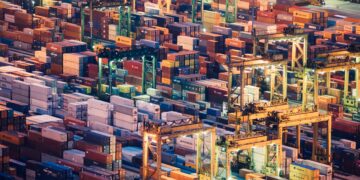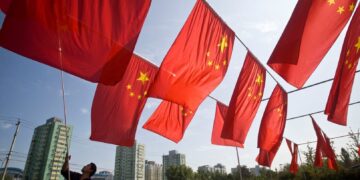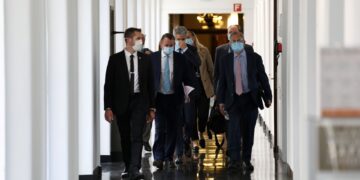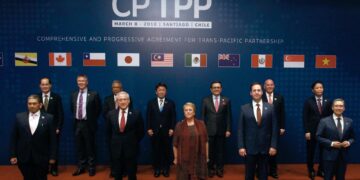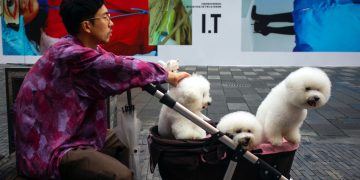By: James McGregor
The recent two sessions of China’s legislature and advisory bodies were resplendent with “core of the core” choreography ensuring everybody was in lock-step with President Xi Jinping, the leader of the Chinese Communist Party, and with the party, the authority on government entities and action. On the policy side, the prevailing narrative was to slow-walk reforms while fast-tracking state-led entrepreneurship and top-shelf technology acquisition.
‘Core of the Core’
Xi sees himself as the party’s third transformative leader behind Mao Zedong and Deng Xiaoping. This was cemented in party nomenclature in October when a party meeting declared Xi as the “core” of the party.
The National People’s Congress (NPC) and the Chinese People’s Political Consultative Conference (CPPCC) were tightly stage-managed rehearsals for the much anticipated 19th Party Congress later this year, at which the new leadership lineup will take the stage.
This was abundantly clear as every public utterance carried a pledge that all things will take place “under the firm leadership of the Central Committee of the Communist Party of China with Comrade Xi Jinping at its core.” As the official Xinhua news agency put it, “safeguarding Xi’s core status is a political issue of utmost importance.”
Premier Li Keqiang, who is rumored to be at odds with Xi and may not get a second term, praised Xi’s “new vision, thinking, and strategies for China’s governance” to make it clear that he is on board with the “core” construct. At the same time, he also raised the eyebrows of the rank-and-file cadres when leaving the stage of his annual press conference with this quip: “See you again, if there’s the opportunity.”
Slow-walking reform
Hanging like the Beijing smog over the proceedings was the visage of President Donald Trump and the unpredictability he brings to US-China ties and world affairs. Faced with such a foreboding landscape, the party signaled that that the extensive economic reforms put forth in 2013 will mostly remain on the shelf for another year.
Without pointing fingers at the United States, Li declared China “ready to face more complicated and graver situations.” Nonetheless, Li also assured delegates that China has the “confidence, the ability, and the means to forestall systemic risks.”
Risk management was certainly high on the agenda of financial regulators, who promised “steady reforms” but seemed determined to not trigger investor losses or financial instability. They promised to rein in shadow banking and impose controls on risky wealth management products that are estimated to have grown to a size equal to 40 percent of GDP.
In celebrating the achievements of 2016, party officials heralded 6.7 percent growth last year, with the service sector accounting for more than 50 percent of GDP and China accounting for 30 percent of global growth. But Li also highlighted “major structural problems” and “prominent risks and dangers” while emphasizing that the “government-market relationship” will be the “pivotal issue in economic and structural reform.”
At times the Chinese leadership promised to cut taxes, reduce fees and reduce red tape to “keep pushing hard” on expanding entrepreneurship and encouraging innovation. While there was much talk of private-public partnerships to encourage private companies to co-invest with state-owned enterprises (SOEs), it was also clear that party plans for SOE reforms will be a drawn-out process in order to control the pace of layoffs and keep the party’s grip on the business world.
The goal of many of these reforms is to increase entrepreneurship. The central and local governments are accelerating the formation of venture capital funds with an emphasis on supporting cloud computing, smart manufacturing, artificial intelligence, virtual reality, and big data. Seed money funds are forming to help the country’s 8 million annual college graduates form new ventures as they face shrinking job prospects.
Li boasted that in 2016, approximately 15,000 new businesses were registered every day in China.
Boosting the consumer sector is a continued priority, and accounts for about two-thirds of China’s GDP growth in 2016. Initiatives outlined by the National Development Reform Commission (NDRC) during the NPC to boost consumer spending included: improving national logistics to decrease the delivery time of quality products to third- and fourth-tier cities, pushing ecommerce in rural areas, promoting tourism, elderly care, vocational training, and entertainment services and facilities.
Regarding real estate, the government is caught between existing property owners who are opposed to price decreases and those who are unable get into the highly priced market. A huge inventory of unsold apartments in secondary cities led to a buying frenzy last year as mortgage terms were eased, with much of the purchasing done by funds that speculated on growth opportunities. This led Li to declare that: “Houses are built to be lived in, not for speculation.” Xi has made similar statements.
Extensive infrastructure investments are still a key part of the economy.This includes the One Belt, One Road campaign, which has China pushing into Southeast Asia, Central Asia, Africa, the Middle East, India, Russia, and Europe with highways, railways, pipelines, information networks, port facilities, and other massive infrastructure projects. Worries about ballooning debt, which went from 160 percent of GDP in 2008 to 260 percent in 2016, has created a predilection for public-private partnerships. So far, much of this involves SOEs and the government, which adds up to public-public partnerships. In short, infrastructure will keep rolling along to absorb overcapacity in the construction industry and help the party keep “performance stable.”
Bottom line for MNCs: A rhetorical gap
Xi and Li emphasized that China is offering expanded opportunities for foreign companies in China. They reiterated a document issued by the State Council in January that outlined loosened restrictions on foreign access to a wide range of sectors and industries in which China needs foreign help to develop domestic competitors, such as banking, securities and fund management, mining, and unconventional oil and gas. The document also encourages foreign investment in Made in China 2025 areas of high-end manufacturing, smart manufacturing, industrial design, modern logistics, test and certification, constructing R&D centers, enterprise technology centers, and post-doctoral research centers.
Foreign businesses have become exhausted by the rhetoric of reform and opening while their on-the-ground existence more closely resembles reform and closing. The government’s pronouncements on level playing fields, equal treatment, and win-win cooperation are falling on deaf ears. The question in the minds of foreign businesses is if the next wave of investment openings will offer opportunities or squeeze foreign businesses out of the market.
As the United States appears to retreat from leading the multilateral trade agenda, globalization is on the top of Chinese leaders’ minds due to China’s dependence on multilateral trade regimes and open markets. Li said that China must “firmly uphold the authority of the multilateral architecture and see that it works effectively; and oppose protectionism in its different forms.”
What’s next?
The Chinese government and foreign business community is focused on what happens after the 19th Party Congress, slated for October or November. Chinese governing patterns are often the opposite of the United States. In their first term, American presidents come in with a mandate and the political capital to get things done. In the second term, the focus turns to who comes next. In China, the first term is focuses on eliminating political enemies and potential challengers and installing loyalists across the bureaucracy. Along the way, he has given organizational structure to an authoritarian ideology and governing system. But Xi still must deal with the economic distortions resulting from three decades of growth-at-all-cost economics.Saving the party has been Xi’s top priority for his first five-year term, with a focus on discipline, repression, and obedience. Saving the country will likely be at the top of his agenda for his second term, which means building a sustainable system that provides sufficient rewards for the citizenry.
In a system in which the leadership appoints itself, power is very fragile. The emergence of Trump and other nationalist political movements in the West has handed China a global leadership role it neither sought, nor is ready for. But now China sits as the leading proponent of globalization and free trade, ironic for a country that has been building ever higher protectionist barriers to foreign business.
This year’s two sessions and the upcoming 19th Party Congress are mired in the consolidation of party power under the core leader of China.
About the author: APCO Worldwide is a global communications consultancy. We help the most innovative organizations adapt and thrive in this fast-moving, interconnected world. Companies undertaking high-stakes transactions face a complex, politicized global landscape. We work with clients and their legal and banking advisors to anticipate risks, align around an integrated communications and public affairs strategy, develop clear and compelling messaging and engage effectively with internal and external stakeholders, influencers and media. APCO gives clients the edge in getting major deals through, and in supporting their longer term goals.

